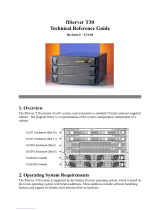
NEC Express5800 Fault Tolerant Virtual Server Quick Start Guide 8
5. Two separate End User Licensing Agreements (EULAs) appear. Read the agreements and click
Continue for both of them to install the software.
6. The installation programs for third-party software run after you click Continue. You must install the
software, because NEC does not support servers that lack this software.
a. When the Java Runtime Environment (JRE) Wizard starts, follow the prompts to install the
JRE, and accept the license agreement and the default settings in the remaining dialog
boxes. (If the progress bars partially obscure the JRE Setup dialog box, click the JRE Setup
dialog box to bring it forward.)
If the Setup Complete dialog box for any third-party software appears, click No, I will restart my computer
later, and then click Finish. If you restart the system now, the installation does not complete properly.
7. When Setup displays the IPL Completed dialog box, click Restart.
8. Restore the default BIOS settings to enable boot monitoring and to enable Option ROM on the PCI
slots. While the system is starting, press F2 to enter the BIOS Setup program. In the BIOS Setup
program, press F9 to restore the default settings, and then press F10 to exit from the BIOS Setup
program. You must enable boot monitoring to maintain fault tolerance.
Make sure that you enable boot monitoring or you will compromise the fault tolerance of the system. The IPL
Procedure turns off boot monitoring.
9. After the system has restarted, log on. The Post Installation Check window appears for several
minutes.
10. The Post Installation Check Tool dialog box appears and runs automatically. This tool verifies that
the install was successful. Click Exit to dismiss the Post Installation Check Tool dialog box.
11. The
Has the NEC ExpressCluster Web service been set up? message box may appear during the
NEC ExpressCluster SRE installation, but it will automatically disappear after 5 seconds. DO NOT
react to this prompt, or the system may appear to hang.
The IPL and post-IPL procedures install the drivers and utilities that are necessary for the server to operate and
fail-over successfully. However, neither process configures other fault tolerant components, such as disk
mirroring and network adapter teaming. It is necessary to complete these configurations after the post-IPL
procedure completes. STEP 3: Configure the Server Hardware describes these procedures.
Using Group Policy to Disable Automatic Updates
The installation of updates from the Microsoft Windows Update site may introduce compatibility problems with
the FT Server. For this reason, you should disable Automatic Updates and install all updates from the NECAM
support website. To ensure that this setting is persistent, you must put your FT Server in an organizational unit
in Active Directory and apply a Group Policy that disables Automatic Updates.
To configure Group Policy to disable Automatic Updates:
1. Create a new organizational unit for the FT Server and move the server into it.
2. Open Group Policy Editor for the organizational unit that contains your NEC Fault Tolerant Server.
3. Navigate to Computer Configuration\Administrative Templates\Windows Components\Windows
Update.
4. In the right-hand pane, double click Configure Automatic Updates and set the value to Disabled.
Figure 5 shows this setting.
5. Click OK.
6. Close Group Policy Editor.
























